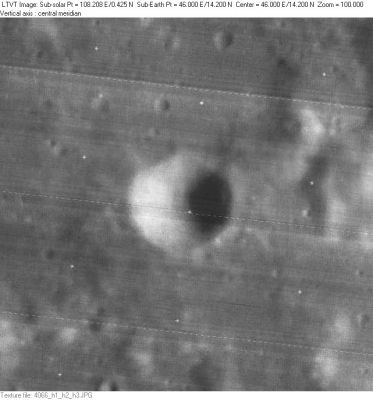Difference between revisions of "Crile"
| Line 7: | Line 7: | ||
|} | |} | ||
<div id="toc"> | <div id="toc"> | ||
| − | + | [http://www.lpod.org/coppermine/albums/userpics/Crile_LO-IV-066H_LTVT.JPG [[Image:normal_Crile_LO-IV-066H_LTVT.JPG|external image normal_Crile_LO-IV-066H_LTVT.JPG]]]<br /> ''[http://lpod.org/coppermine/displayimage.php?pos=-2663 LO-IV-066H]''<br /> <br /> | |
| − | |||
==Images== | ==Images== | ||
[http://www.lpod.org/coppermine/thumbnails.php?album=search&type=full&search=Crile LPOD Photo Gallery] [http://www.lpi.usra.edu/resources/lunar_orbiter/bin/srch_nam.shtml?Crile%7C0 Lunar Orbiter Images] [http://www.lpi.usra.edu/resources/apollo/search/feature/?feature=Proclus%20F Apollo Images]<br /> - Because '''Crile''''s ('''Proclus F''''s) location is not very far away of the pronounced high-albedo crater '''Proclus''', it should be very easy to detect it on the panoramic ''ITEK''-camera frames made during Apollo 15 and Apollo 17.<br /> <u>'''Crile''' on ''ITEK'' frames</u>:<br /> - '''Crile''' was captured on Apollo 17's panoramic ''ITEK''-camera frames [http://www.lpi.usra.edu/resources/apollo/frame/?AS17-P-2702 AS17-P-2702] and [http://www.lpi.usra.edu/resources/apollo/frame/?AS17-P-2707 AS17-P-2707]. In both frames, '''Crile''' is the crater at centre of your screen (you don't have to scroll toward the frame's right margin).<br /> - In Apollo 15's [http://www.lpi.usra.edu/resources/apollo/frame/?AS15-P-9509 AS15-P-9509], it ('''Crile''') was captured at the central part of the frame (scroll to the right).<br /> - A southward oblique look at '''Crile''' is Apollo 15's [http://www.lpi.usra.edu/resources/apollo/frame/?AS15-P-9245 AS15-P-9245] ('''Crile''' is the crater very near the upper left corner of the frame).<br /> - Additional research orbital Apollo photography: Danny Caes<br /> <br /> | [http://www.lpod.org/coppermine/thumbnails.php?album=search&type=full&search=Crile LPOD Photo Gallery] [http://www.lpi.usra.edu/resources/lunar_orbiter/bin/srch_nam.shtml?Crile%7C0 Lunar Orbiter Images] [http://www.lpi.usra.edu/resources/apollo/search/feature/?feature=Proclus%20F Apollo Images]<br /> - Because '''Crile''''s ('''Proclus F''''s) location is not very far away of the pronounced high-albedo crater '''Proclus''', it should be very easy to detect it on the panoramic ''ITEK''-camera frames made during Apollo 15 and Apollo 17.<br /> <u>'''Crile''' on ''ITEK'' frames</u>:<br /> - '''Crile''' was captured on Apollo 17's panoramic ''ITEK''-camera frames [http://www.lpi.usra.edu/resources/apollo/frame/?AS17-P-2702 AS17-P-2702] and [http://www.lpi.usra.edu/resources/apollo/frame/?AS17-P-2707 AS17-P-2707]. In both frames, '''Crile''' is the crater at centre of your screen (you don't have to scroll toward the frame's right margin).<br /> - In Apollo 15's [http://www.lpi.usra.edu/resources/apollo/frame/?AS15-P-9509 AS15-P-9509], it ('''Crile''') was captured at the central part of the frame (scroll to the right).<br /> - A southward oblique look at '''Crile''' is Apollo 15's [http://www.lpi.usra.edu/resources/apollo/frame/?AS15-P-9245 AS15-P-9245] ('''Crile''' is the crater very near the upper left corner of the frame).<br /> - Additional research orbital Apollo photography: Danny Caes<br /> <br /> | ||
| Line 24: | Line 23: | ||
* [http://en.wikipedia.org/wiki/George_Washington_Crile George Washington Crile] (January 7, 1864 - November 11, 1943) was a significant American surgeon. Crile is now formally recognized as the first surgeon to have succeeded in a direct blood transfusion. | * [http://en.wikipedia.org/wiki/George_Washington_Crile George Washington Crile] (January 7, 1864 - November 11, 1943) was a significant American surgeon. Crile is now formally recognized as the first surgeon to have succeeded in a direct blood transfusion. | ||
| − | * This replacement name for a formerly [[lettered%20crater|lettered crater]] was provisionally introduced on [http://www.lpi.usra.edu/resources/mapcatalog/LTO/lto61b2_1/ LTO-61B2]. <span class="membersnap">- | + | * This replacement name for a formerly [[lettered%20crater|lettered crater]] was provisionally introduced on [http://www.lpi.usra.edu/resources/mapcatalog/LTO/lto61b2_1/ LTO-61B2]. <span class="membersnap">- Jim Mosher</span> |
<br /> | <br /> | ||
==LPOD Articles== | ==LPOD Articles== | ||
| Line 31: | Line 30: | ||
<br /> <br /> | <br /> <br /> | ||
---- | ---- | ||
| − | + | </div> | |
Revision as of 16:18, 15 April 2018
Contents
Crile
(formerly Proclus F)
|
Lat: 14.2°N, Long: 46.0°E, Diam: 9 km, Depth: 2.02 km, Rükl: 37 |
Images
LPOD Photo Gallery Lunar Orbiter Images Apollo Images
- Because Crile's (Proclus F's) location is not very far away of the pronounced high-albedo crater Proclus, it should be very easy to detect it on the panoramic ITEK-camera frames made during Apollo 15 and Apollo 17.
Crile on ITEK frames:
- Crile was captured on Apollo 17's panoramic ITEK-camera frames AS17-P-2702 and AS17-P-2707. In both frames, Crile is the crater at centre of your screen (you don't have to scroll toward the frame's right margin).
- In Apollo 15's AS15-P-9509, it (Crile) was captured at the central part of the frame (scroll to the right).
- A southward oblique look at Crile is Apollo 15's AS15-P-9245 (Crile is the crater very near the upper left corner of the frame).
- Additional research orbital Apollo photography: Danny Caes
Maps
(LAC zone 61B2) LAC map Geologic map LTO map
Description
Description: Wikipedia
Additional Information
- Depth data from Kurt Fisher database
Westfall, 2000: 2.02 km
Viscardy, 1985: 1.5 km - Included on the ALPO list of banded craters
Nomenclature
- George Washington Crile (January 7, 1864 - November 11, 1943) was a significant American surgeon. Crile is now formally recognized as the first surgeon to have succeeded in a direct blood transfusion.
- This replacement name for a formerly lettered crater was provisionally introduced on LTO-61B2. - Jim Mosher
LPOD Articles
Bibliography
